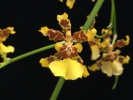|
|
|
|
|
| |
Flasks of
Oncidium sphacelatum 'MC2964' -spontaneous |
|
| |
|
|
| |
| Number: |
TN4780 |
| Name: |
Oncidium sphacelatum 'MC2964' -spontaneous
|
| Type: |
spontaneous (What's that?) |
|
Click to Enlarge

Offspring 'MC7146' Flower |
| Offspring photos are siblings of the plants you would receive. |
|
|
|
| |
Culture Notes from Donor: Parent plant: Temperature range I (60-83°F)
Comments: Parent plant: Large plant.
For additional origin/habitat information supplied courtesy of
Charles and Margaret Baker, see further below, near the bottom of this page.
|
Temperatures we attempt to use in the lab & greenhouse:
| For Species: |
|
Spring, Summer, Autumn: days average 81°F, nights 68°F; best fit is Warm-Intermediate 87-64°F
(Source:
Baker's Web OSC) |
| For Species: |
|
Winter: days average 72°F, nights 61°F; best fit is Cool-Intermediate 75-58°F
(Source:
Baker's Web OSC) |
|
About the name...
| Etymology of |
Oncidium |
|
From Greek "onkos" tumor, swelling. Refers to the warty callus of the labellum.
(Source:
Pridgeon 1992) |
| Etymology of |
sphacelatum |
|
From Latin "sphacelatus" burned, with burned spots.
(Source:
Mayr & Schmucker 1998) |
| Pronunciation of |
Oncidium |
|
on-SID-ee-um
(Source:
Pridgeon 1992) |
| Pronunciation of |
sphacelatum |
|
sfah-se-LAH-tum
(Source:
Hawkes 1978) |
|
If you would like to direct someone to this web page, please copy and paste this URL into your email:
http://troymeyers.com/d?014780
| Flask Information |
| Availability: |
We have sold all of the flasks for this item. |
| You should: |
Consider getting individual plants or compots instead of a flask.
See if we have plants available in the greenhouse. |
| Yield Estimate: |
440 plants (based on flask surveys done 01/24/2005 through 10/04/2005)
|
| Plantlet Sizes: |
From many flasks 0.3 - 60 mm plants (based on flask surveys done 11/15/2004 through 02/21/2006)
From one most recently surveyed flask 30 - 60 mm (02/21/2006)
|
|
You might also want to:
|
View the seed assay for this item.
See if we have plants available in the greenhouse.
View items of the same species.
View items of the same genus.
|
| Ordering Information |
| You are not currently logged in. |
|
You must be a registered user and be logged in to reserve a flask or place a notification request. Please log in:
|
|
|
|
|
|
| |
The origin/habitat information below is supplied courtesy of Charles and Margaret Baker
The following information is based on the name of the plant provided by the donor, and assumes that the name is correct. If the plant has been misidentified, then the following information may not be correct.
This text is copyrighted by the Bakers and may not be reproduced without permission.
ORIGIN/HABITAT: Mexico, Belize, Guatemala, El Salvador, and Honduras. In
Mexico, this orchid is found on low hills, usually below 3300 ft. (1000
m), bordering the Gulf of Mexico from San Luis Potosí and Veracruz
southward. It grows on trees. Plants are common throughout Belize where
they grow on trees and rocks in thickets or forests up to 2600 ft. (800
m). In Guatemala, plants grow on both the Gulf and Pacific slopes.
More about this information and the Bakers...
|
|
|
| |
|
|
|